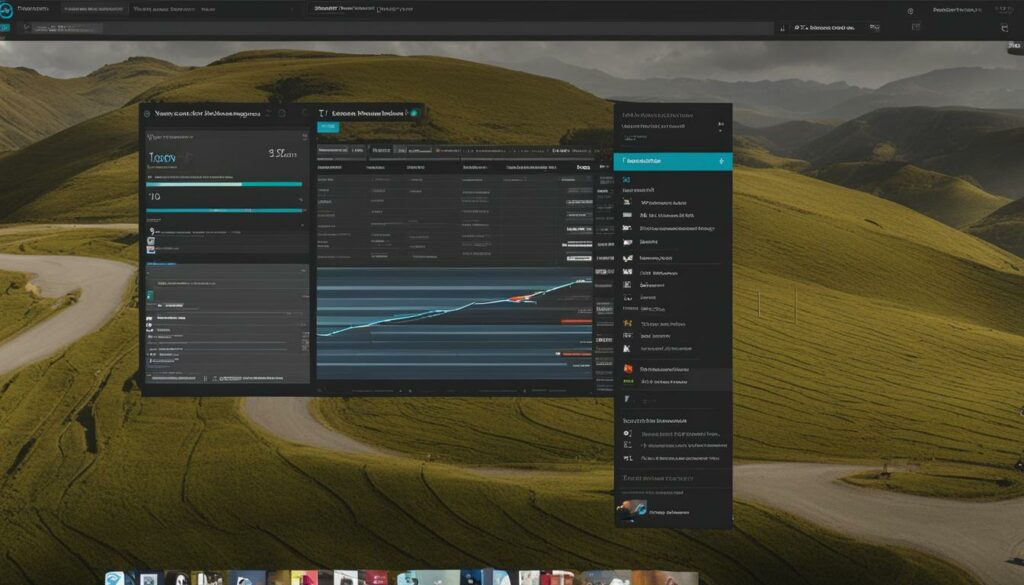Are you tired of guessing how to improve your website’s performance? Want to make data-driven decisions that actually deliver results? Look no further than Google Analytics. This powerful tool is a game-changer for website owners, providing valuable insights into visitor behavior, traffic sources, and conversion rates. But how can you utilize Google Analytics effectively to take your website to the next level?
Key Takeaways:
- Google Analytics is a powerful tool for tracking and analyzing website performance.
- By utilizing Google Analytics effectively, you can make data-driven decisions to improve your website.
- Key metrics to analyze include bounce rate, behavior flow, traffic sources, and keywords.
- Setting up Google Analytics involves adding the tracking code to your website and setting up email reports.
- Analyzing website paths and navigation can optimize the user experience and improve conversions.
- Identifying low-performing pages through Google Analytics can help you focus on SEO wins.
Key Metrics to Analyze in Google Analytics
When it comes to leveraging the power of Google Analytics, understanding the key metrics and reports is crucial. Regularly analyzing these metrics allows you to make data-driven decisions that can greatly improve your website’s performance and drive success. Let’s explore some of these key metrics and how they can provide valuable insights into your website’s performance.
Bounce Rate
One of the important metrics to analyze in Google Analytics is the bounce rate. This metric measures the percentage of visitors who navigate away from your site after viewing only one page. A high bounce rate can indicate that visitors are not finding what they’re looking for or that your site’s design and content may need improvement. By tracking and analyzing the bounce rate, you can identify areas of your website that need attention to reduce bounce rates and improve user engagement.
Geographic Breakdown
Analyzing the geographic breakdown of website traffic can provide valuable insights into potential new markets. Google Analytics allows you to see where your visitors are located and the regions that are driving the most traffic to your site. By understanding the geographic distribution of your audience, you can tailor your marketing efforts and content to better cater to these regions and maximize your website’s impact.
Behavior Flow
The behavior flow report in Google Analytics helps you understand how visitors navigate through your website and can provide insights into their intent. By visualizing the path visitors take from one page to another, you can identify the most common paths and potential areas where visitors drop off. This analysis enables you to make informed decisions about optimizing your website’s navigation, improving user experience, and increasing conversions.
Sources of Traffic
Understanding the sources of traffic to your website is essential for effective marketing strategies. Google Analytics provides detailed reports on the sources of traffic, including direct traffic, organic search, social media, and referral traffic. By analyzing this data, you can identify which channels are driving the most traffic and optimize your marketing efforts accordingly. This insight allows you to allocate resources and focus on the channels that bring the most value to your website.
User Flow
The user flow report in Google Analytics offers valuable insights into how visitors interact with your website. It visualizes the paths visitors take and the actions they perform, showcasing which pages and elements attract the most attention. By analyzing user flow, you can identify popular entry points, areas with high drop-off rates, and opportunities for optimizing user journeys. This analysis helps you refine your website’s design and content to create a smooth and engaging user experience.
Keywords Driving Visits
Keywords are critical for driving organic search traffic to your website. Google Analytics allows you to track the keywords that are bringing visitors to your site from search engines. By analyzing these keywords, you can identify the ones that drive the most visits and optimize your content to further improve your search engine rankings. This keyword analysis enables you to fine-tune your SEO strategy and attract more targeted traffic to your website.
When it comes to improving your website’s performance, tracking and analyzing these key metrics in Google Analytics is essential. By gaining insights into your visitors’ behavior, traffic sources, and keyword performance, you can make data-driven decisions that optimize your website and drive success.
Setting Up Google Analytics for Your Website
If you want to track and collect valuable data on your website’s performance, setting up Google Analytics is essential. By adding the Google Analytics tracking code to your site, you enable the tool to gather important insights into visitor behavior. Here’s how to get started:
Step 1: Accessing the Google Analytics Tracking Code
To obtain the tracking code, you’ll need to have a Google Analytics account. If you don’t already have one, go to analytics.google.com and sign up. Once you have an account, follow these steps:
- Log in to your Google Analytics account and select the website you want to track.
- Click on the Admin tab in the lower-left corner of the screen.
- Under the Property column, click on Tracking Info and then Tracking Code.
- Copy the tracking code provided.
Step 2: Adding the Tracking Code to Your Website
Now that you have the tracking code, it’s time to implement it on your website. The process may vary depending on the platform you’re using. Here are some general steps:
- Open your website’s HTML source code in a text editor.
- Locate the <head> section of your code.
- Paste the tracking code you copied from Google Analytics just before the </head> tag.
- Save the changes and publish your website.
Once the tracking code is successfully implemented, Google Analytics will start collecting data on your website’s performance.
Step 3: Setting Up Email Reports
Google Analytics allows you to receive email reports on key metrics and insights, saving you time and providing a quick overview of your website’s performance. Here’s how to set up email reports:
- Log in to your Google Analytics account.
- Select the website you want to receive reports for.
- Click on Customization in the left-hand menu.
- Under the Custom Reports section, click on Email.
- Configure the settings for your email report, including the frequency and format.
- Save your settings to start receiving regular email reports.
With email reports, you can keep track of important metrics without having to log in to Google Analytics regularly.
Step 4: Creating Custom Alerts
In addition to email reports, you can also create custom alerts in Google Analytics. These alerts will notify you of specific events or issues related to your website. To create custom alerts, follow these steps:
- Log in to your Google Analytics account.
- Select the website you want to set up alerts for.
- Click on Admin in the lower-left corner of the screen.
- Under the View column, click on Custom Alerts.
- Click on New Alert and configure the settings for your alert.
- Click on Save Alert to activate it.
Custom alerts can help you stay informed about any sudden changes or issues affecting your website’s performance.
By setting up Google Analytics, adding the tracking code, and configuring email reports and custom alerts, you can gather valuable insights into your website’s performance and make data-driven decisions to optimize its success.
“Setting up Google Analytics is like turning on the lights in a dark roomâit illuminates valuable data on your website’s performance and visitor behavior.”
| Key Steps | Description |
|---|---|
| Step 1: Accessing the Google Analytics Tracking Code | Obtain the tracking code from your Google Analytics account. |
| Step 2: Adding the Tracking Code to Your Website | Implement the tracking code in your website’s HTML source code. |
| Step 3: Setting Up Email Reports | Configure email reports to receive regular updates on key metrics and insights. |
| Step 4: Creating Custom Alerts | Create custom alerts to receive notifications for specific events or issues. |

Optimizing Website Paths and Navigation
Analyzing website paths and navigation is essential for optimizing the user experience and improving website performance. By studying the behavior flow report in Google Analytics, website owners can understand how visitors navigate through their site and identify areas where visitors tend to drop off. This information can help optimize website design, improve content placement, and enhance the overall user experience. By strategically placing calls to action and optimizing the navigation paths, website owners can guide visitors towards desired actions and improve conversions.
When analyzing the behavior flow report in Google Analytics, you can visualize the paths visitors take as they interact with your website. This report presents a visual representation of how your website’s pages are connected and the most common paths users take. Understanding the behavior flow allows you to identify potential bottlenecks or confusing elements in your website’s navigation.
One effective way to optimize website paths and navigation is to strategically place calls to action throughout your website. By strategically positioning buttons or links that lead visitors to important pages or actions, you can guide them towards desired conversions. For example, you can highlight a “Buy Now” button on product pages or add a prominent “Contact Us” link in your website header.

Improving User Experience with Clear Navigation
In addition to calls to action, optimizing the navigation menu is crucial for improving website paths and enhancing user experience. Here are some best practices for website navigation:
- Keep the navigation menu clear and concise, using clearly labeled categories that match users’ expectations.
- Include a search bar to help users quickly find what they’re looking for.
- Use breadcrumbs to provide users with a clear path to navigate back to previous pages or categories.
- Ensure the navigation menu is easily accessible and visible on all pages of your website.
By implementing these navigation best practices and leveraging insights from the behavior flow report in Google Analytics, you can optimize website paths and navigation, leading to improved user experience, increased engagement, and higher conversions.
Leveraging Low-Hanging Fruit Pages for SEO Wins
Google Analytics provides valuable insights into search queries that are currently sending traffic to your website. By analyzing the search queries report, you can identify low-performing pages that have the potential to rank higher in search results. These pages present opportunities to optimize and improve their performance, ultimately boosting your search rankings and organic traffic.
One way to optimize low-performing pages is by improving their page load times. Slow-loading pages can negatively impact user experience and result in high bounce rates. By optimizing the page speed using techniques like image optimization, minifying code, and leveraging caching, you can enhance the user experience and keep visitors engaged.
Another crucial element of optimization is adding more valuable content to these pages. Conduct keyword research to identify relevant long-tail keywords that align with the content and user intent. By incorporating these keywords naturally and providing high-quality, informative content, you increase the chances of ranking higher in search results.
You should also make sure that the low-performing pages are mobile-responsive. With the increasing number of people accessing websites through mobile devices, having a mobile-friendly website is crucial for both user experience and search rankings. Optimize the design and layout of these pages to ensure they display properly on different screen sizes.
By focusing on optimizing these low-hanging fruit pages, you can significantly improve your search performance. The impact of these optimizations can lead to increased organic traffic, higher search rankings, and ultimately, more leads and conversions. Take advantage of the insights provided by Google Analytics to identify these opportunities and prioritize your efforts for maximum impact.

| Optimization Technique | Benefits |
|---|---|
| Improving page load times |
|
| Adding valuable content |
|
| Making pages mobile-responsive |
|
Conclusion
Google Analytics is a powerful tool that can greatly improve your website’s performance. By using best practices and analyzing key metrics, you can make data-driven decisions to attract more traffic and achieve higher conversions. Regularly monitoring and analyzing data in Google Analytics will help you understand visitor behavior and identify areas for improvement.
Setting up email reports and alerts will ensure that you stay informed about your website’s performance without any extra effort. By implementing these best practices, you can continuously optimize your website and stay ahead of the competition.
Remember, improving website performance is an ongoing process. By leveraging the insights provided by Google Analytics and implementing the recommended strategies, you can achieve lasting success and continue to grow your online presence.
FAQ
Q: How can I use Google Analytics to improve my website?
A: Google Analytics is a powerful tool that provides valuable insights into various aspects of your website’s performance. By analyzing key metrics and reports, you can make data-driven decisions to enhance your website design, content, and marketing strategies. It allows you to track visitor behavior, analyze traffic sources, and monitor conversion rates, enabling you to identify areas for improvement and optimize your website’s performance.
Q: What are some key metrics I should analyze in Google Analytics?
A: There are several important metrics and reports in Google Analytics that you should regularly analyze. These include the bounce rate, which shows the percentage of visitors who leave your site after viewing only one page. Other metrics to consider are the geographic breakdown of website traffic, behavior flow, sources of traffic, users flow, and keywords driving visits. These metrics can provide insights into visitor behavior and help you optimize your website for better performance.
Q: How do I set up Google Analytics for my website?
A: Setting up Google Analytics for your website involves adding the tracking code provided by Google Analytics to your site. This code allows the tool to track and collect data on visitor behavior. Once the tracking code is implemented correctly, you can set up email reports to receive regular updates on key metrics and insights. By creating custom alerts, you can also receive notifications for specific events or issues related to your website.
Q: How can I optimize website paths and navigation using Google Analytics?
A: By studying the behavior flow report in Google Analytics, you can understand how visitors navigate through your site and identify areas where they tend to drop off. This information can help you optimize your website design, improve content placement, and enhance the overall user experience. By strategically placing calls to action and optimizing the navigation paths, you can guide visitors towards desired actions and improve conversions.
Q: How can I leverage low-hanging fruit pages for SEO wins using Google Analytics?
A: Google Analytics provides insights into search queries that are currently driving traffic to your website. By analyzing the search queries report, you can identify low-performing pages that have the potential to rank higher in search results. These pages often present opportunities for optimization by improving page load times, adding valuable content, and making them mobile-responsive. By focusing on optimizing these pages, you can improve your search performance, increase organic traffic, and generate more leads and conversions.
Q: How can I improve my website performance using Google Analytics best practices?
A: To improve your website performance using Google Analytics best practices, it’s important to regularly monitor and analyze data, set up email reports and custom alerts, and implement optimization strategies based on insights gained from the tool. By consistently analyzing key metrics, studying visitor behavior, and optimizing your website design, you can make data-driven decisions that lead to increased traffic, higher conversions, and overall website success.












